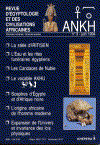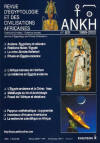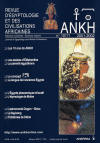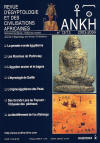|
ANKH n°1,
février 1992, pp. 51 - 58.

ANKH n°2,
avril 1993, pp. 8 - 18.

ANKH n°3,
juin 1994, pp. 28 - 50.

ANKH n°4-5, 1995/1996, pp. 138 - 183.

ANKH n°6-7, 1997/1998, pp. 9 - 53.

ANKH n° 8-9, 1999-2000, pp. 86 - 85.

ANKH n° 8-9, 1999-2000, pp. 96 -
97.
ANKH n° 8-9, 1999-2000, pp. 182 -
186.
ANKH n°10-11, 2001-2002, pp. 106 -
131.

ANKH n°10-11, 2001-2002, pp. 72 -
84.
ANKH n°12-13,
2003-2004, pp.
48-63.

ANKH n°14-15,
2005-2006, pp.
8-33.

ANKH n°16,
2007,
pp.
8-27.

ANKH n°16,
2007,
pp.
98-108.
ANKH n°17,
2008,
pp. 86-131.

|
L e
"chamito-sémitique" n'existe pas
Résumé : Théophile
OBENGA, qui est
l'auteur de travaux majeurs dans ce domaine de la linguistique
africaine (cf. bibliographie), montre dans "Le
'chamito-sémitique' n'existe pas",
en quoi l'existence de la famille linguistique
"chamito-sémitique" ou "afro-asiatique" qui regrouperait les
langues sémitiques (accadien, ugaritique, phénicien, hébreu,
arabe, sud-arabique), l'égyptien (ancien égyptien, copte),
le berbère (siwa, mzab, tuareg, kabyle, rifain), les
langues couchitiques (sidamo, gedeo, burji, galla, beja,
etc.) et les langues tchadiques (hausa, mada, zelgwa),
n'est pas fondée scientifiquement, c'est-à-dire qu'elle n'a
jamais été reconstruite par la méthode de la linguistique
historique qui est comparative et inductive ; on sait que cette
méthode, appliquée à l'indo-européen, par exemple, a fait les
preuves de sa pertinence et de sa validité.
Aristote et l’Égypte ancienne
Résumé : La place prédominante tenue
dans l’Antiquité par l’Égypte ancienne sur le plan intellectuel,
scientifique (astronomie, mathématiques… ) est illustrée, ici,
par la présentation et l’analyse de multiples références à
l’Égypte faites par le célèbre philosophe grec ARISTOTE
dans son œuvre. Une lecture attentive, serrée des
textes montre qu’ARISTOTE
a visité l’Égypte.
Abstract :
Aristotle and the Ancient Egypt — Through the presentation and
analysis of the many references which the famous Greek
philosopherARISTOTLE made
in his works, to Egypt, this article illustrates the dominant
position occupied, in Antiquity, by ancient Egypt at the
intellectual and scientific (astronomy, mathematics… ) levels.
An attentive and close reading of the texts shows that ARISTOTLE
visited Egypt.
La Stèle d'IRITISEN
ou le premier Traité d'Esthétique de l'humanité
Résumé :
Le scribe IRITISEN,
qui vécut au Moyen Empire sous les pharaons MENTOUHOTEP
(vers 2030 av. J.C.) se présente lui-même comme le chef des
artistes et comme sculpteur. Une stèle lui est dédiée. Elle est
actuellement exposée au Musée du Louvre, à Paris, où elle porte
le numéro C 14. Après avoir rappelé l'ensemble des travaux et
traductions dont elle a déjà fait l'objet, l'auteur entreprend
une étude approfondie de la grande inscription de la stèle d'IRITISEN
: translittération, traduction, et commentaire où sont
interpellés, le lexique, la grammaire, l'esthétique, les
techniques de l'art et l'histoire. Son ancienneté et son contenu
en font le premier Traité d'Esthétique de l'humanité.
Abstract :
The Stele of IRITISEN or
humanity's first Treatise on esthetics —
IRITISEN the scribe, who
lived during the Middle Egyptian Empire under the MENTOUHOTEP
Pharaohs (~ 2030 B.C.) talks of himself as the head of the
artists and as sculptor. A stele was dedicated to him and it may
be seen today at the Louvre Museum (Paris) where it bears the
reference number C14. Having recalled past works and
translations dealing with the stele, the author investigates it
thoroughly ; transliteration, translation and commentaries where
lexicology, grammar, esthetic, art techniques and history are
all brought to bear. Its age and its content make it humanity's
first treatise on esthetics.
La parenté égyptienne -
Considérations sociologiques
Résumé : Cette étude
traite de la parenté égyptienne en examinant les points
suivants: composition familiale, familles et occupations
professionnelles, dimension diachronique de la parenté,
terminologie égyptienne de la parenté, circoncision, famille et
société. Les traits significatifs du système parental
pharaonique frappent par leur similitude avec la plupart des
systèmes de parenté africains modernes. Il est également acquis
que l'égyptien et le sémitique ne partagent ensemble aucun
terme de parenté. La théorie des deux berceaux de civilisation
de Cheikh Anta Diop trouve ici une démonstration anthropologique
et linguistique probante.
Abstract :
The Egyptian relationships : sociological considerations — This study
deals with the Egyptian relationship and analyses the following
points : family structure, families and professional
occupations, diachronic dimension of the relationship, Egyptian
terminology of relationship, circumcision, family and society.
The significant features of the pharaonic relationship system
are stricklingly similar to most of the modern African
relationship systems. It is also admitted that Egyptian and
Semitic share no terms of relationship in common. The
theory of the two craddles of civilization of Cheikh Anta DIOP
finds here a convincing anthropologic and linguistic
demonstration.
Anthropologie pharaonique. Textes
à l'appui
Résumé : Restituer
l'image conceptuelle que la société de l'Egypte pharaonique
s'est faite de l'être humain, directement à partir des textes
hiéroglyphiques, tel est l'objet du présent article.
L'investigation de l'auteur porte sur un ensemble de concepts
Egyptiens fondamentaux tels que ren (le nom), ib
et haty (le coeur), ka, ba,
akh, ...
Il met en relief la complexité sous-jacente à ces notions qui
concourent à la définition de l'immortalité. L'auteur
montre, grâce au recours au texte égyptien, à l'iconographie et
à la linguistique, l'unité psychologique, culturelle qui lie
dans la profondeur historique l'Egypte des Pharaons au reste de
l'Afrique noire. L'antériorité de cette "longue tradition
négro-égyptienne" est soulignée ainsi que son influence sur les
peuples sémitiques et indo-européens attestée par son empreinte
laissée dans le judaïsme et le christianisme.
Abstract :
Pharaonic
Anthropology with the Support of Texts —
To restore the conceptual image that Pharaonic society
had of the human being straight from the hieroglyphical texts
such is the purpose of this article. The author's investigations
concern the set of fundamental Egyptian concepts made up by ren (the name), ib and haty
(the heart), ka, ba, akh. He
brings out the underlying complexity of these notions which work
towards the definition of immortality. The author shows,
resorting to Egyptian texts, iconography and to linguistics, the
psychological and cultural unity which links in the depth of
History the Egypt of the Pharaohs to the rest of Black Africa.
The precedence of this long Negro-African traditions underlines
as well its influence on Semitic and Indo- European populations
testified by imprint it left on Judaism and Christianity
Africa, the Cradle of Writing
The study of
writing provides a rich domain of cultural history and ideas
which interwave the disciplines of philosophy and religion,
linguistics and humanistic inquiry.
In his book entitled The Aryan
Origin of The Alphabet published in London in 1927,
L.A. Waddell believed that the alphabet had been invented by
the Sumero-Phoenicians who were not "a Semitic people". But
Waddell’s text was produced in support of his ideological
and racial stance, that is, the superiority of the so-called "Aryan"
race.
John D. Ray,
a British scholar, made the same historical distortion when he
stated that "idea of writing" came to Egypt from Sumer.
Sumer was an ancient civilization of
Mesopotamia, in the present day South Iraq, that reached the
height of its power under Akkadian dynasty, founded by Sargon
around 2340 B.C.
As we know, Sanchoniathon's Book,
which is a Phoenician account of genesis and cosmogony, clearly
points out that writing was invented by the Egyptians and it was
transmitted to the Phoenicians.
In Plato's Phaedrus
(274 c-d), Socrates reminds Greek collective memory that ta grammata, that is, "the letters", "the writing systems"
were first invented in Kemet (i.e. Ancient Egypt,) thanks to the
divine principle known as Thoth.
Sir Arthur John Evans (1851-1941),
a British archaeologist, who unearthed remnants of the Bronze
Age Minoan civilization in Crete (an island of South East
Greece in the Eastern Mediterranean Sea), believed quite rightly
that most of the Cretan glyphs were borrowed from the Egyptian
system of writing : see his book entitles Scripta Minoa
(Oxford : Clarendon Press, 1909) with 132 illustrations, 13
plates and 26 tables.
L'hématome du rocher
Résumé : L'auteur
présente, translittère, traduit et commente le cas 21 du Papyrus
médical Edwin Smith portant sur la fracture d'un os situé à la
base du crâne et appelé le rocher. Cette blessure affecte
l'ouïe.
Abstract
: The
haematoma of the petrosal bone —
The
author presents, transliterates, translates and comments the case of the medical Edwin Smith Papyrus concerning the
fracture of a bone situated at the basis of the skull which is
called the petrosal bone. This wound impairs the hearing.
Calcul du volume de
la pyramide
Résumé :
L'auteur présente, transcrit en
hiéroglyphes, translitère et traduit l'un des problèmes du
Papyrus démotique mathématique référencé J.E. 89141-43 qui
traite du volume d'une pyramide.
Abstract : Process of calculating the volume of the
pyramid —
The author
presents, transcripts into hieroglyphs, transliterates and
translates one of the problems of the demotic
mathematical Papyrus referenced J.E. 89141-43 which deals with
the volume of a pyramid.
L'Egypte
pharaonique et Israël dans l'Antiquité
Résumé
: L'auteur
expose la chronologie comparée de l'histoire de l'Egypte
pharaonique et d'Israël. Il montre quelles ont été, dans
l'Antiquité, les relations entre l'ƒgypte ancienne et Israël. Il
souligne l'influence culturelle profonde qu'a exercée l'Egypte
ancienne sur le peuple des Hébreux qui a vécu sur le territoire
égyptien pendant plusieurs siècles.
Abstract : Pharaonic Egypt and Israel in the
Antiquity — The author exposes
the compared historical chronology of Pharaonic Egypt and of
Israel. He shows what were the relations between ancient Egypt
and Israel in Antiquity. He underlines the deep cultural
influence which Egypt exerted on the Hebrew people living on the
Egyptian territory during several centuries.
L'Egyptien
ancien n'est pas une langue sémitique, ni une langue
chamito-sémitique, mais une langue négro-africaine. Réponse à l'égyptologue Pascal VERNUS.
Ancient Egyptian
is not a semitic, neither chamito-semitic language but a black
african language. Answer to egyptologist Pascal VERNUS.
Comparaisons
morphologiques entre l'Egyptien ancien et le Dagara
Résumé :
Cette étude comparative
entre égyptien pharaonique et dagara est strictement conduite
pour illustrer les questions difficiles de méthodologie en
linguistique historique. Les jeunes générations de chercheurs
africains ont en effet besoin de cadres réflexifs et
méthodologiques rigoureux.
Abstract : Morphological comparisons
between ancient Egyptian and Dagara — This comparative research
between Pharaonic Egyptian and Dagara language is crucial for
its exemplary dealing with methodological issues in the field of
historical linguistics. Indeed, new African generations must
have apppropriate framework in order to undertake their studies
with rigor and soundness.
Sexualité, amour et mariage en
Egypte et en Grèce dans l'antiquité
Résumé :
L’auteur conduit, avec rigueur, à partir des sources
documentaires primaires (textes, iconographie, …), une étude
comparative sur la sexualité, l’amour et le mariage en Égypte
ancienne (Kmt) et en Grèce antique (Hellas). Deux modèles
culturels très différents se dégagent avec leurs spécificités
sociales et psychologiques relatives au statut de la femme dans
l’Antiquité.
Abstract : Sexuality, love and marriage in
Egypt and Greece — In
this comparative study author’s intent is to conduct with rigor
and from primary sources (texts, iconography, …) an examination
concerning sexuality, love and marriage in Ancient Egypt (Kmt)
and Ancient Greece (Hellas). Two very different cultural
patterns do appear with their specific social and psychological
features dealing with female social status in Antiquity.
Rencontre de Martin BERNAL et Théophile
OBENGA
Peigne et
concept de « cheveu » en égyptien ancien
Résumé : Le mot égyptien
pharaonique “shenou” signifie à la fois “cheveu” et “herbe”
parce que les cheveux sont comme de l’herbe sur la tête,
c’est-à-dire, frisés, crépus. Le terme grec correspondant est “oulotrichein”,
“avoir les cheveux crépus”, tel qu’il a été utilisé par Hérodote
pour décrire les anciens Égyptiens.
Comb
and concept of “hair” in ancient Egyptian
Abstract :
Comb and concept of “hair” in ancient Egyptian - The Pharaonic
Egyptians word “shenu” means at the same time “hair” and “grass”
because hair were like grass on the head, that is kinky, frizzy,
and tightly curled. The Greek corresponding term is “oulotrichein”,
“to have curly hair”, as used by Herodotus describing Egyptian
people.
Ancient Egyptian and Modern Yoruba : Phonetic Regularity
Abstract :
This exploratory study, according to the linguistic comparative
method, tries to show that large numbers of cognate lexical
items are available between Egyptian pharaonic language and
Modern Yoruba of Nigeria.
Égyptien ancien et Yoruba moderne : régularité phonétique
Résumé
: Cette étude exploratrice, selon la
méthode de la linguistique comparative, essaie de montrer qu’il
existe une quantité suffisante de faits lexicaux hérités entre
l’Egyptien pharaonique et le Yoruba moderne parlé au Nigéria.
La déesse Isis et son odyssée en
Europe occidentale
Résumé
:
Platon, Tacite,
Novalis et Gérard de Nerval, d'une part, d'autre part, Grecs,
Romains, Gaulois et Germaniques, tous ont reconnu et célébré la
déesse égyptienne Aset (forme grécisée : Isis).
C'est dire la profonde et durable influence de la Spiritualité
de l'Égypte pharaonique sur les peuples d’Occident, des Balkans
aux Pyrénées, et de l'Italie antique en Germanie romaine. Le
culte de Marie de l'Église catholique romaine a lui-même pour
prototype direct les cultes isiaques. L'archéologie confirme les
dépositions des auteurs anciens. Cette étude rassemble
l'essentiel des témoignages crédibles, passés au crible de la
critique historique et du bon sens.
The
Goddess Isis in her Western European Peregrinations
Summary:
Plato, Tacitus, Novalis, and Gérard de Nerval, as well as
Greeks, Romans, Celts of ancient Gaul, and indigenous tribesmen
of the land we know as Germany, all have come to give
recognition to the Egyptian goddess and freely celebrate
Aset (converted into a Greek form as Isis). It
means that Pharaonic Spirituality had a far-reaching influence
on Western societies from the Balkan Peninsula to the Pyrenees
(between France and Spain), and from Rome up to Germany, and the
Roman Catholic cult of Mary itself has as early and direct
prototype the cult of Isis.
On this critical
issue, archaeological data and written records are conclusive
in the light of historical analysis and explanation.
|

